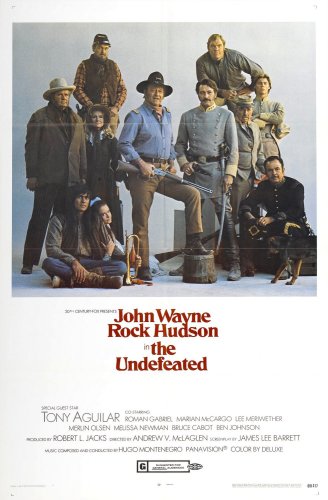

During the opening titles, as refugees file past the camera, its shadow is visible during the whole shot.
At the end of the film, as everyone rides slowly toward the camera, a red pickup truck enters from the right and casually drives alongside the river in the background.
The cavalry uniforms are Indian Wars vintage, not Civil War uniforms.
After the Civil War (1861-65) when the cowboys are around the campfire, Webster talks of sending a letter and that it could go Pony Express.
The Pony Express dissolved in October of 1861.
It also did not go into South Texas where the cowboys apparently where traveling.
In the opening scene, Union soldiers are marching past the screen carrying a flag with 48 stars on it.
During the Civil War the Union flag only had either 34 or 35 stars.
The movie is set in 1865.
The Confederates are using 1873 Springfield Trapdoor rifles, The Mexican bandit leader is using a 1873 Trapdoor Carbine, John Wayne is using a 1873 Colt Peacemaker and an 1892 Winchester rifle.
Looking closely, you can see the rifle of the tenth member of the firing squad.
Also you can plainly see his shadow on the ground at a 10 o' clock position.
There are several other shots that confirm the number.
At the end of the last close up shot of John Wayne in the movie, a green pickup truck can be seen entering the frame in the background on the opposite side of the river.
When Colonel Langdon leaves to go ask John Henry to give up his horses to save the Colonels men, he leaves and the sun is still up.
He is shown riding at a full gallop at sunset and arrives at John Henry's camp sometime around daybreak.
John Henry and his men take the herd back at a walk and still arrive just before noon, covering the same amount of ground at a walk in less than 6 hours, that the Colonel traveled all night to cover.
The characters, both Mexican and American, keep referring to the war against Maximilian as a "revolution.
" As the Juarez government had never fled Mexico during the intervention, and consistently insisted it was the lawful government, no loyal Mexican would consider the war a revolution; it was the expulsion of a foreign invader.
A number of times in the early part of the movie reference is made to the surrender of Lee to Grant as the end of the war.
Although the surrender of Lee is now seen as the effective end of the war, at the time it was not, and would not have been considered such by most people (the Confederate major in the opening battle being an example).
Organized military operations continued for a number of months after Lee's surrender.
When John Henry Thomas and Colonel Langdon meet for the first time, Colonel Langdon makes reference to Colonel Thomas' cavalry being with Custer at Gettysburg.
Thomas was also supposed to be at the Battle of Shiloh.
Further, it is obvious from the beginning of the movie that Thomas was a colonel of volunteers (not a regular officer).
None of the volunteer cavalry at Shiloh was at Gettysburg, so Thomas' unit could not have been present at both battles.
After the Civil War, ex-Union Colonel John Henry Thomas (John Wayne) is leading his horses to be sold to the Mexican government. In the meanwhile, ex-Confederate Colonel James Langdon (Rock Hudson) is leading a rag-tag group of southerners who are going south to escape the Yankee mob.
Yes, I DID create a new account. It's about time that people start giving others the truth and challenging those that want to put the most disgusting UNTRUE reviews.
A pretty straightforward film about Mrs. Palins accomplishments, her supporters and her detractors.
"Moments that surged into a wave of momentum, republican party leaders didn't see it coming." A documentary covering Sarah Palin's rise from Mom to Mayor to VP candidate and beyond.
Good rebuttal to the character assassination by the media at large. I found the documentary interesting, and it filled in some info gaps.
One of John Wayne's best. To the point and not a lot of unnecessary gab.
Obviously contrived with the box office in mind, this is an OK western that sees John Wayne (the rough and ready Yankee colonel) and Rock Hudson (the suave, debonaire, but broke, plantation owning Confederate colonel) and their respective ex-soldiers form an uneasy partnership after the US Civil war, to drive some horses to their new owner, Emperor Maximilian of Mexico. En route, they have the usual sequence of "Red River" (1948) style escapades before encountering treachery on a fairly grand scale that puts the lives of themselves and their horses at risk.
When I first saw this film (I have no idea when) I have a hand written note next to it which simply says "muddled". And so I decided to watch it again and my second viewing concurs with my original view.
In the aftermath of the Civil War, Union Colonel John Henry Thomas and colleagues plan to run 2,000 horses to Mexico at roughly the same time and over roughly the same route as a group of settlers headed by Confederate Colonel James Langdon. After assorted shenanigans, some of which are not unconnected with Civil War resentments, things go pear-shaped in Mexico.